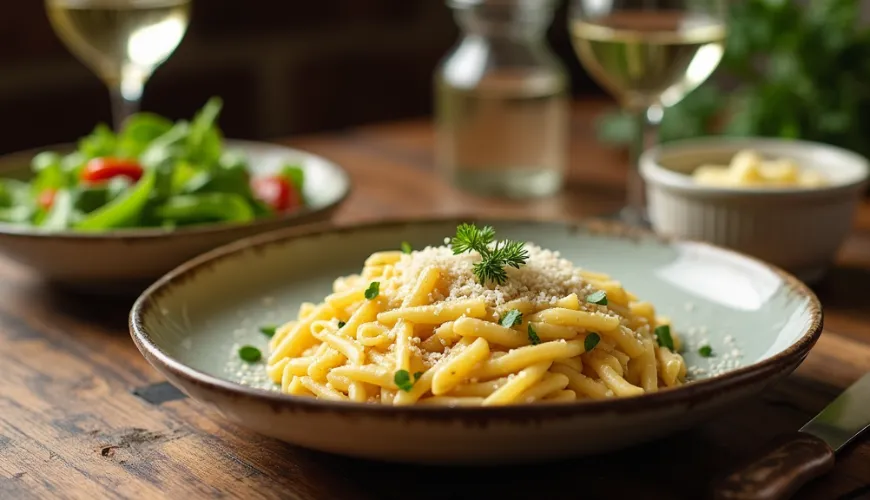
Why You Should Include Orzo in Your Diet

Orzo, a small pasta shaped like grains of rice, is still a relatively undiscovered treasure in Czech kitchens. Yet it has much to offer—not only its versatility but also its ability to complement both traditional and modern dishes beautifully. If you haven't heard of it yet, you might be surprised to learn that it's not a grain, as its appearance might suggest, but small pasta made from durum wheat. In Italian cuisine, it's known as risoni, in Greek as kritharaki, and in Arab countries as lisān al-ʿuṣfūr—translated as "bird's tongue." It has its place in all these cuisines. And perhaps it's time for it to find a place in ours too.
What is orzo and why should you include it in your diet?
Orzo looks like a cross between rice and traditional pasta, but its taste is closer to pasta. Its advantage is that due to its size, it softens quickly, making cooking with it a matter of minutes. It's made from durum wheat semolina, giving it a velvety yet firm texture—ideal for soups, salads, risottos, or baked dishes.
Nutritionally, it has similar values to other pastas. Orzo is a source of complex carbohydrates, providing energy evenly and over a longer time. In its whole-grain variant, it can offer more fiber and micronutrients like magnesium or phosphorus. Although it's not a gluten-free food, people without celiac disease can enjoy it in a healthy diet.
In recent years, orzo has become a popular alternative among fans of the Mediterranean diet. This diet is long considered one of the healthiest in the world—and small pasta like orzo plays an important role in it. It pairs well with vegetables, legumes, fish, and olive oil.
Using orzo in the kitchen
One of the greatest strengths of this inconspicuous pasta is its versatility. You can add it to hot soups, where it creates a hearty base, or cool it down and mix it into a refreshing summer salad with tomatoes, cucumber, and yogurt dressing. In Greece, orzo is often baked in casserole dishes with tomato sauce and lamb—a dish known as giouvetsi.
The popularity of “orzotto” is also rising, a sort of variation on risotto where orzo is used instead of rice. The result is similarly creamy, but the preparation is often quicker. With the right technique, orzo absorbs the broth just like arborio rice without overcooking.
For inspiration, consider a typical workweek example. Imagine a family looking for a quick dinner after a long day—something hearty yet light. The mom grabs a pack of orzo pasta from the pantry, adds sautéed onions, spinach, garlic, and a bit of cream. The result is a delicious pasta risotto with minimal effort and maximum flavor. The kids enjoy it, and the parents appreciate the simplicity of the preparation.
Tips for cooking orzo without mistakes
Whether you enjoy orzo as a light side dish or as the main course, one thing is certain—the key to success is its proper preparation. Cooking orzo isn't rocket science; just immerse it in plenty of salted water, like regular pasta, and let it simmer for about eight to ten minutes until it softens to the bite. However, if you plan to use orzo in a creamy dish, consider another method—it works great when cooked directly in broth or with other ingredients.
This way, it nicely absorbs the flavor while naturally thickening the dish, which is always a bonus in the kitchen. And if you’re preparing it for a cold salad or worry it might stick together, simply rinse it briefly with water after cooking. One last trick—if you plan to bake orzo, leave it slightly undercooked. In the oven, it will soften perfectly as it melds with the other flavors and achieves perfection.
This small pasta has another advantage that anyone who likes to plan ahead will appreciate—it’s great for meal prep. Cooked orzo lasts several days in the fridge and can easily be incorporated into various recipes—whether with grilled vegetables, leftover roasts, or in a lunchbox for work.
Favorite orzo recipe
To showcase orzo pasta in the best light, nothing beats sharing a specific recipe you can easily prepare at home. This dish is ideal for vegetarians, but meat lovers can add roasted chicken or sautéed tofu.
Ingredients:
- 250 g orzo pasta
- 1 small onion, finely chopped
- 2 cloves of garlic
- 250 g mushrooms, sliced
- 100 g fresh spinach leaves
- 750 ml vegetable broth
- 100 ml cooking cream (can be substituted with plant-based cream)
- Olive oil, salt, pepper
- Parmesan or its plant-based alternative (optional)
Instructions:
- In a deep pan, sauté the onion in olive oil until golden, add garlic, and shortly after, the mushrooms. Sauté until they soften and release their juices.
- Add the orzo and briefly toast it to coat in the fat and flavors.
- Pour in enough broth to submerge the pasta and cook, stirring occasionally, until the liquid is absorbed and the orzo softens—about 10 minutes.
- Add the cream, spinach, and season with salt and pepper. Cook for another 2–3 minutes until the spinach wilts and the dish thickens.
- Serve with shaved Parmesan or nutritional yeast for a vegan version.
The result is a delicate and fragrant dish, suitable for a warm lunch or a lunchbox the next day. It tastes great even cold.
"When you don't know what to cook, reach for pasta—but try it differently," says renowned Italian chef Massimo Bottura. Orzo is precisely that different choice, yet it doesn’t seem exotic or complicated.
In a time when more people are interested in what they eat and are looking for ways to combine taste, nutrition, and simplicity, orzo becomes a small helper with great potential. You can always have it on hand, use it in dozens of recipes, and explore the flavors of Mediterranean and home kitchens with it.
Whether you add it to soup, salad, or prepare a warming dish by the spoonful, one thing is certain—orzo pasta deserves a place in every modern kitchen.

